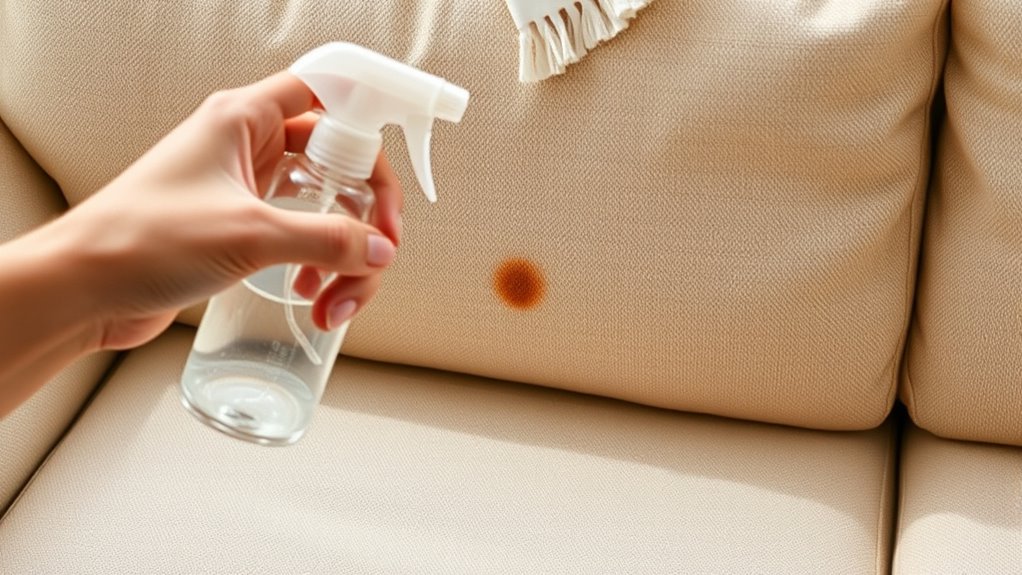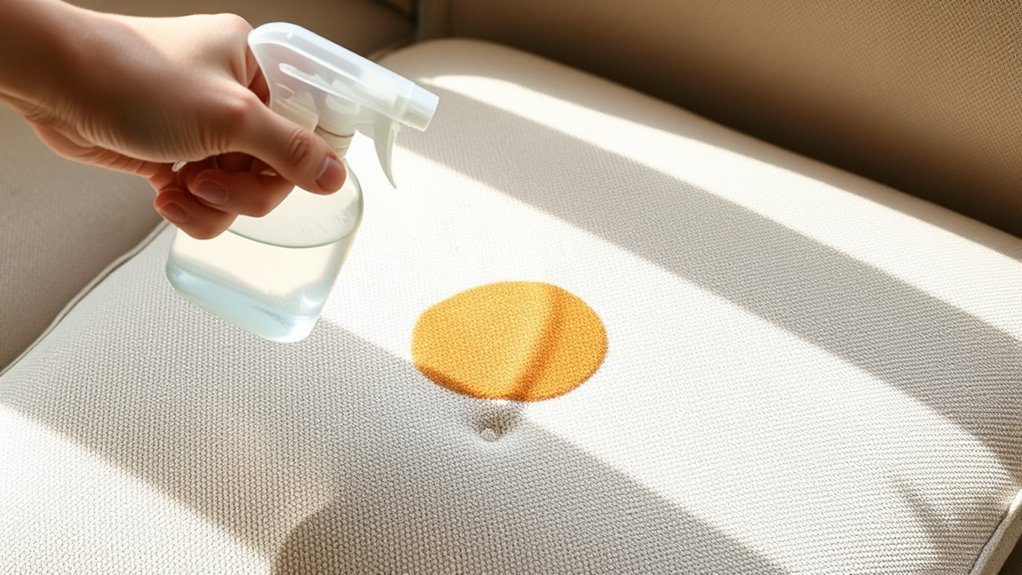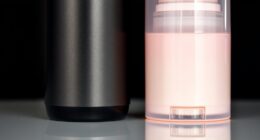To remove stains without damaging your fabric, act quickly and blot—never rub—the spill while using a gentle solution like warm water mixed with dish soap. For tougher stains, try a mix of equal parts white vinegar and water or sprinkle baking soda on oily spots before vacuuming. Rinse treated areas with a damp cloth and pat dry, always testing solutions first. Keep your couch looking fresh and learn more tips to keep stains at bay.
Key Takeaways
- Blot stains immediately with a clean, dry cloth to prevent setting and spread.
- Use mild solutions like warm water mixed with dish soap or a vinegar-water mix for stubborn stains.
- Test cleaning agents on small, hidden areas to avoid discoloration or fabric damage.
- Apply cleaning solutions sparingly and dab gently, avoiding excessive soaking or scrubbing.
- Rinse treated spots with a damp cloth, then dry thoroughly to prevent mold and preserve fabric integrity.

Your couch is often the centerpiece of your living space, so taking proper care of it can extend its lifespan and keep it looking fresh. When stains appear, it’s tempting to grab the harshest cleaners or scrub relentlessly, but that can do more harm than good. Instead, focus on gentle, targeted treatments that nuke stains without nuking your fabric. The key is to act quickly and use the right approach for your specific material. First, identify what caused the stain and determine your fabric type—whether it’s microfiber, cotton, or a synthetic blend. This info guides your cleaning method, helping you avoid damage or discoloration.
For most common stains, like spills or food messes, start by blotting—never rubbing—using a clean, dry cloth or paper towel. Rubbing pushes the stain deeper and can fray or distort the fabric. Once you’ve absorbed as much as possible, prepare a mild cleaning solution. A simple mix of warm water and a few drops of dish soap usually works well. Test this solution on a small, inconspicuous area first to ensure it doesn’t cause discoloration. If it’s safe, dampen a clean cloth with the mixture and gently dab the stain. Avoid soaking the fabric, as too much moisture can lead to mold or fabric damage.
For tougher stains, like wine or coffee, you might need a more targeted approach. Consider using a mixture of equal parts white vinegar and water—this natural solution can break down many stains without harming fibers. Apply it sparingly with a cloth, then blot with a dry towel to lift the stain. For grease or oil, sprinkle a small amount of baking soda onto the stain and let it sit for 15 minutes before vacuuming it up. The baking soda absorbs the oil, making it easier to remove. Additionally, detecting passive voice can make your cleaning instructions clearer and more direct, enhancing your overall writing effectiveness.
Always remember to avoid harsh chemicals or bleach, which can weaken fabric fibers and cause discoloration. After treating the stain, rinse the area with a clean, damp cloth to remove any residue, then pat dry with a towel. If possible, air out the fabric to help it dry completely and prevent musty odors. Regular maintenance, like vacuuming and quick stain treatment, will keep your couch looking its best. By staying gentle and patient, you can effectively eliminate stains without compromising your fabric, ensuring your couch remains inviting and in top shape for years to come.
Frequently Asked Questions
Can I Use Homemade Cleaning Solutions on All Fabric Types?
You can’t use homemade cleaning solutions on all fabric types safely. Some fabrics, like silk or velvet, are delicate and can be damaged by harsh ingredients. Always check the care label first. Test any solution on a small hidden area before applying widely. For safe results, stick to products recommended for your specific fabric, or consider professional cleaning for sensitive or expensive materials.
How Do I Remove Stubborn Stains Without Damaging the Couch?
Did you know that 85% of fabric stains can be removed with proper treatment? To tackle stubborn stains, gently blot the area with a mixture of mild dish soap and water, avoiding scrubbing. Use a clean cloth to lift the stain, and repeat if necessary. Always test your solution on a hidden spot first. This prevents damage while effectively removing tough spots.
Are There Any Specific Precautions for Cleaning Microfiber or Leather Couches?
Yes, you should always test a small, hidden area first before cleaning microfiber or leather couches. Use gentle cleaners specifically designed for each material, avoiding harsh chemicals or excessive water. For microfiber, opt for a soft brush and mild soap; for leather, use a damp cloth and leather conditioner. Keep the room well-ventilated and avoid excessive moisture to prevent damage.
How Often Should I Deep Clean My Couch to Prevent Stains?
You should deep clean your couch every 3 to 6 months to prevent stains and maintain freshness. Studies show that regular cleaning extends furniture lifespan by up to 30%. By staying consistent, you prevent dirt and grime from setting in, making stain removal easier. Use gentle cleaning solutions suitable for your couch’s fabric or leather, and always follow manufacturer guidelines. This routine keeps your furniture looking new longer.
What Tools Are Best for Gentle Stain Removal?
You should use soft tools like a microfiber cloth or a soft-bristled brush for gentle stain removal. A clean, damp cloth can lift fresh stains without damaging the fabric. For stubborn spots, try a mild upholstery cleaner or a mixture of water and a gentle detergent. Always test on a hidden area first to verify it won’t cause discoloration. Gentle tools and mild solutions protect your couch’s fabric while effectively removing stains.
Conclusion
Think of your couch as a treasured garden—delicate, yet resilient. With the right care, you’re watering it with gentle solutions and pruning away stains without tearing the fabric’s roots. Each spill becomes just a temporary shadow passing over a vibrant landscape. Keep nurturing it with patience and smart cleaning, and your sofa will bloom with lasting beauty. Remember, a little care today keeps the stains and damage at bay, letting your couch shine like a well-tended oasis.









